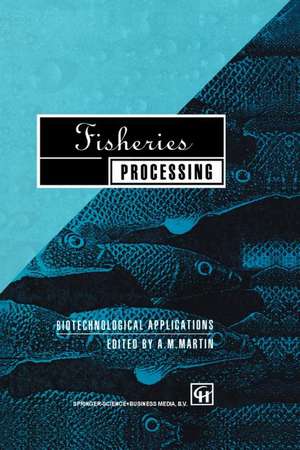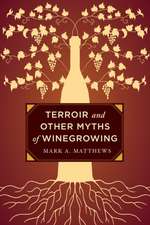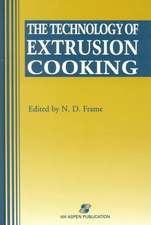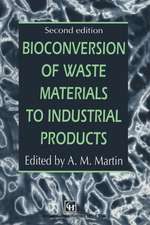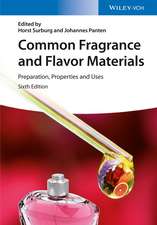Fisheries Processing: Biotechnological applications
Editat de A.M. Martinen Limba Engleză Paperback – 29 sep 2012
| Toate formatele și edițiile | Preț | Express |
|---|---|---|
| Paperback (1) | 955.08 lei 6-8 săpt. | |
| Springer Us – 29 sep 2012 | 955.08 lei 6-8 săpt. | |
| Hardback (1) | 968.65 lei 6-8 săpt. | |
| Springer Us – 30 mai 1999 | 968.65 lei 6-8 săpt. |
Preț: 955.08 lei
Preț vechi: 1164.73 lei
-18% Nou
Puncte Express: 1433
Preț estimativ în valută:
182.81€ • 198.64$ • 153.66£
182.81€ • 198.64$ • 153.66£
Carte tipărită la comandă
Livrare economică 21 aprilie-05 mai
Preluare comenzi: 021 569.72.76
Specificații
ISBN-13: 9781461374206
ISBN-10: 1461374200
Pagini: 520
Ilustrații: XV, 494 p.
Dimensiuni: 155 x 235 x 27 mm
Greutate: 0.72 kg
Ediția:1994
Editura: Springer Us
Colecția Springer
Locul publicării:New York, NY, United States
ISBN-10: 1461374200
Pagini: 520
Ilustrații: XV, 494 p.
Dimensiuni: 155 x 235 x 27 mm
Greutate: 0.72 kg
Ediția:1994
Editura: Springer Us
Colecția Springer
Locul publicării:New York, NY, United States
Public țintă
ResearchDescriere
The fish processing industry is still far from the levels of scientific and technological development that characterize other food processing oper ations. It has also been slow in finding uses for by-products and processing wastes, compared with the meat and poultry industries. The utilization of fisheries by-products or wastes constitutes an area in which the application of modern techniques could potentially improve profitability. At present, increased attention is being focused on the application of new biotechnological methods to operations related to the seafood industry, with the objective of increasing its general efficiency. Because fish processing operations are commonly carried out in the vicinity of the sea, most of the resulting fish wastes have been disposed of by returning them to it. Pollution control measures and a better understanding of the valuable composition of the products extracted from the sea are expected to encourage their recovery and the develop ment of new products from them. In the past, fisheries wastes and species not used for food have been generally utilized through techno logical processes with a low level of sophistication, such as those for the production of animal feed and fertilizer. Limited economic success has accompanied the application of physi cal and chemical processes for the recovery of non-utilized fisheries biomass and for the production of quality products from them.
Cuprins
One Processing Quality Control.- 1 Microbiological quality of fishery products.- 1.1 Introduction.- 1.2 Harvesting.- 1.3 Onboard handling.- 1.4 Fishing vessel sanitation and HACCP.- 1.5 Processing.- 1.6 Preservatives.- 1.7 Summary.- References.- 2 Rapid methods and automation for seafood microbiology.- 2.1 Introduction.- 2.2 Improvements in sampling and sample preparation.- 2.3 Alternative methods for the viable cell count procedure.- 2.4 New methods for estimation of microbial populations and biomass.- 2.5 Miniaturized microbiological techniques.- 2.6 New and novel techniques.- 2.7 Conclusions.- Acknowledgment.- References.- 3 Microbiological control for fish smoking operations.- 3.1 Introduction.- 3.2 Smoking of fish: technological aspects.- 3.3 Smoking industry.- 3.4 Microbiology of fish smoking processes.- 3.5 Conclusions.- Acknowledgments.- References.- 4 New packaging technology for seafood preservation — shelf-life extension and pathogen control.- 4.1 Introduction.- 4.2 Quality and nutritional value of seafood.- 4.3 Food preservation methods.- 4.4 Packaging for seafood.- 4.5 Modern food packaging.- 4.6 Processed seafood as a chilled convenience product.- 4.7 Conclusions.- Acknowledgments.- References.- Two Fisheries Biomass Bioconversion.- 5 Traditional fermented fish: fish sauce production.- 5.1 Introduction.- 5.2 Types of traditional fermented fish products.- 5.3 Fish sauce production.- 5.4 Processing of fish sauce.- 5.5 Changes during fermentation.- 5.6 Microbiology of fish sauce.- 5.7 Chemistry of fish sauce.- References.- 6 Proteases from aquatic organisms and their uses in the seafood industry.- 6.1 Introduction.- 6.2 General properties and applications of proteases.- 6.3 Criteria for selection of a protease in industry.- 6.4 Classification of fish proteases.- 6.5 Traditional applications of proteases in the seafood industry.- 6.6 Recent applications of fish proteases in the seafood industry.- 6.7 Other potential applications of fish proteases in industry.- 6.8 Conclusion.- References.- 7 Bioprocessing of chitin and chitosan.- 7.1 Introduction.- 7.2 General properties of chitin and chitosan.- 7.3 Methods for preparing chitin.- 7.4 Methods for preparing chitosan.- 7.5 Advantages of biological versus chemical methods for preparing chitin/chitosan.- 7.6 Applications of chitin and chitosan.- 7.7 Conclusion.- References.- 8 Applications of crustacean wastes in biotechnology.- 8.1 Introduction.- 8.2 Quality and composition of crustacean waste.- 8.3 Recovery of crustacean waste components.- 8.4 Applications of products recovered from crustacean wastes.- References.- 9 Production of fish protein concentrates.- 9.1 Introduction.- 9.2 Fishmeal and fish protein concentrate.- 9.3 Fish protein hydrolyzate.- 9.4 Characteristics and functional properties of fish products.- 9.5 Utilization of fish products.- References.- 10 Production of fish protein hydrolyzates by microorganisms.- 10.1 Introduction.- 10.2 Solubilization of fish mince.- 10.3 Microbial proteases.- 10.4 Biotechnological approaches to fish meat solubilization.- 10.5 Solubilization of fish meat by immobilized microbial cells.- 10.6 Future prospects.- Acknowledgment.- References.- 11 Production of fish silage.- 11.1 Introduction.- 11.2 Background.- 11.3 Raw materials.- 11.4 Composition and chemical changes.- 11.5 Production methods.- 11.6 Physical properties of silage.- 11.7 Metal corrosion in silage production.- 11.8 Processing of silage.- 11.9 Silage quality.- 11.10 Nutritional value.- 11.11 Conclusions.- References.- 12 Lactic acid and propionic acid fermentations of fish hydrolyzates.- 12.1 Introduction.- 12.2 Enzymatic hydrolysis of fish tissue.- 12.3 Effectiveness of lactic acid and propionic acid fermentations.- 12.4 Characteristics of the lactic acid and propionic acid bacteria.- 12.5 Growth media and culture maintenance.- 12.6 Materials and methods.- 12.7 Results.- 12.8 Discussion.- 12.9 Commercial sources of lactic acid bacteria, propionic acid bacteria and papain.- References.- 13 Mussel processing wastes as a fermentation substrat.- 13.1 Mussel and mussel processing wastes in the Galician Rias.- 13.2 Direct treatment of non-concentrated MPW.- 13.3 Treatment of concentrated MPW.- 13.4 MPW as a raw material: outlook.- Acknowledgments.- References.- 14 Waste water treatment for fisheries operations.- 14.1 Introduction.- 14.2 Sources and characteristics of seafood processing waste waters.- 14.3 Treatment technologies.- 14.4 Technology selection.- 14.5 Conclusions.- Acknowledgments.- References.- Three Aquaculture Applications.- 15 Microbial biomass as a source of protein in the feeding of cultivated fish.- 15.1 Introduction.- 15.2 Supplementary foods in fish culture.- 15.3 Microbial biomass protein.- 15.4 Microbial biomass as food for fish culture.- 15.5 A case study: utilization of C. utilis biomass as a feed for aquaculture.- 15.6 Conclusions.- Acknowledgments.- References.- 16 Coloring of salmonids in aquaculture: the yeast Phaffia rhodozyma as a source of astaxanthin.- 16.1 Introduction.- 16.2 Sources of astaxanthin.- 16.3 Quantitation of astaxanthin.- 16.4 The yeast P. rhodozyma.- 16.5 P. rhodozyma as an astaxanthin source for salmonids.- 16.6 Production of P. rhodozyma.- 16.7 Increase in astaxanthin production by P. rhodozyma.- 16.8 Economical considerations.- 16.9 Future use of P. rhodozyma and astaxanthin in salmonid farming.- Acknowledgments.- References.- 17 Fish vaccines: development, production and use of bacterial vaccines, with special reference to salmon.- 17.1 Introduction.- 17.2 Antibiotics versus fish vaccines.- 17.3 Fish immunology.- 17.4 Humoral and cellular immunity.- 17.5 Uptake of vaccines.- 17.6 Fish diseases.- 17.7 Bacterial vaccines.- 17.8 Isolation and characterization of pathogenic bacteria.- 17.9 Laboratory fermentation analysis and scaling up of fermentation.- 17.10 Vaccine production.- 17.11 Tests, field trials and approval for sale.- 17.12 Vaccination methods.- 17.13 Future use of vaccines.- References.
